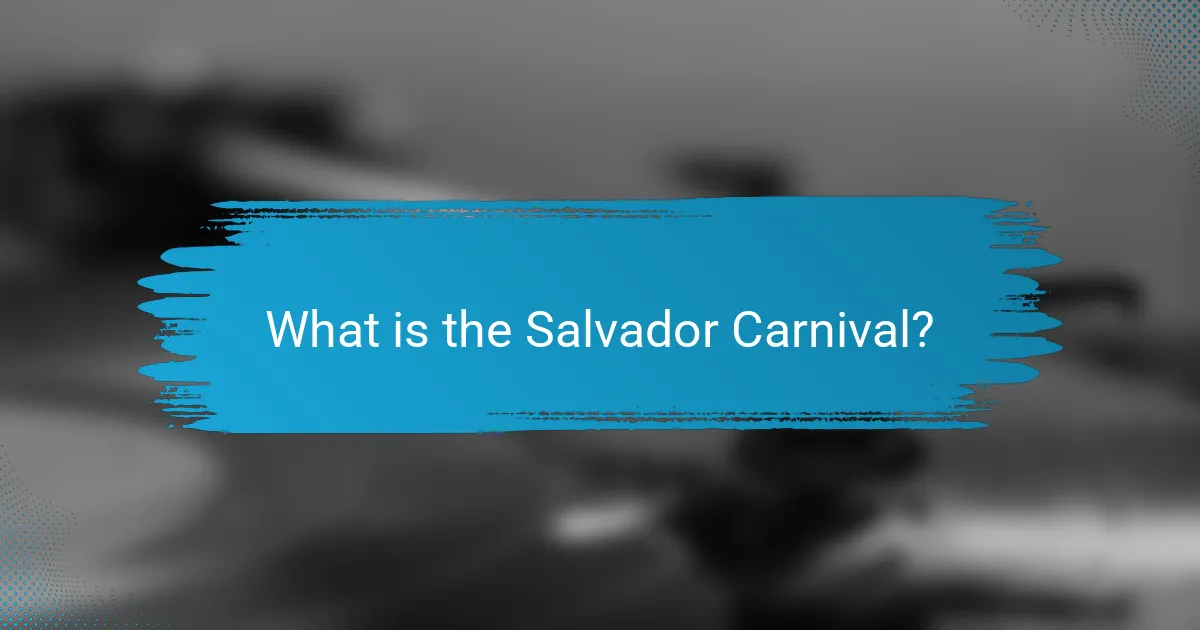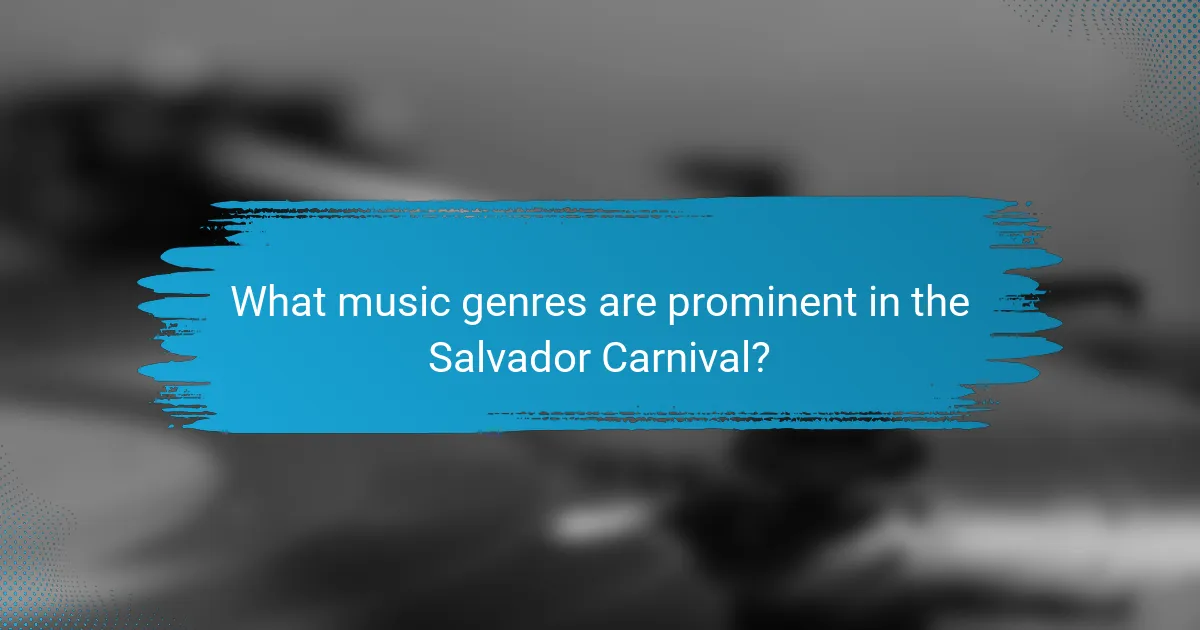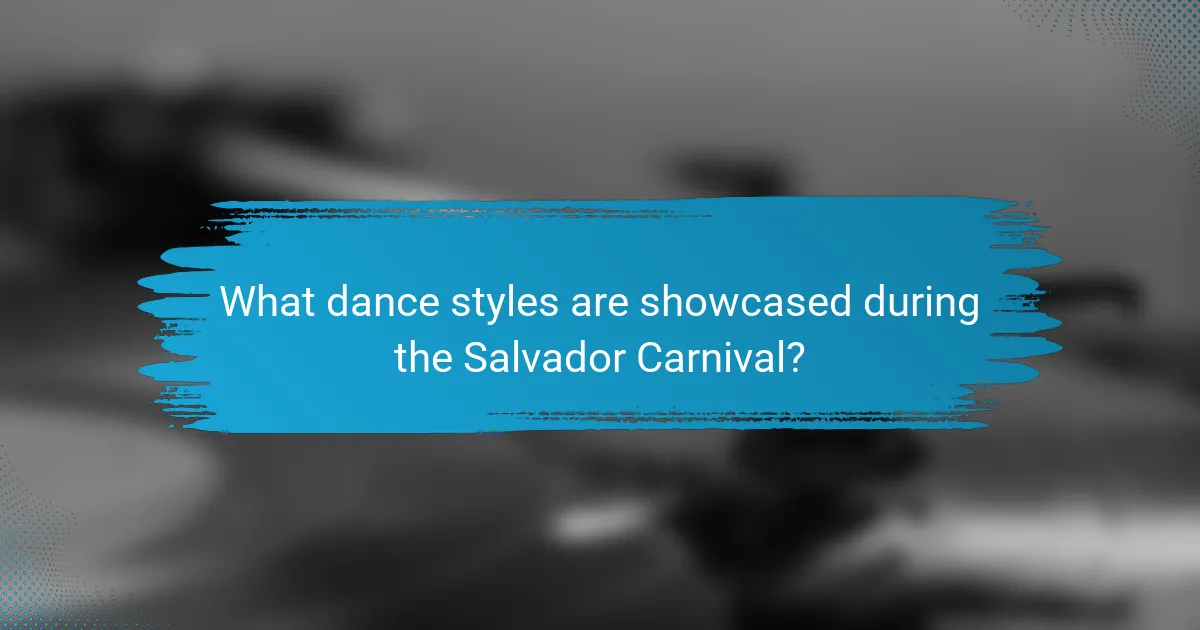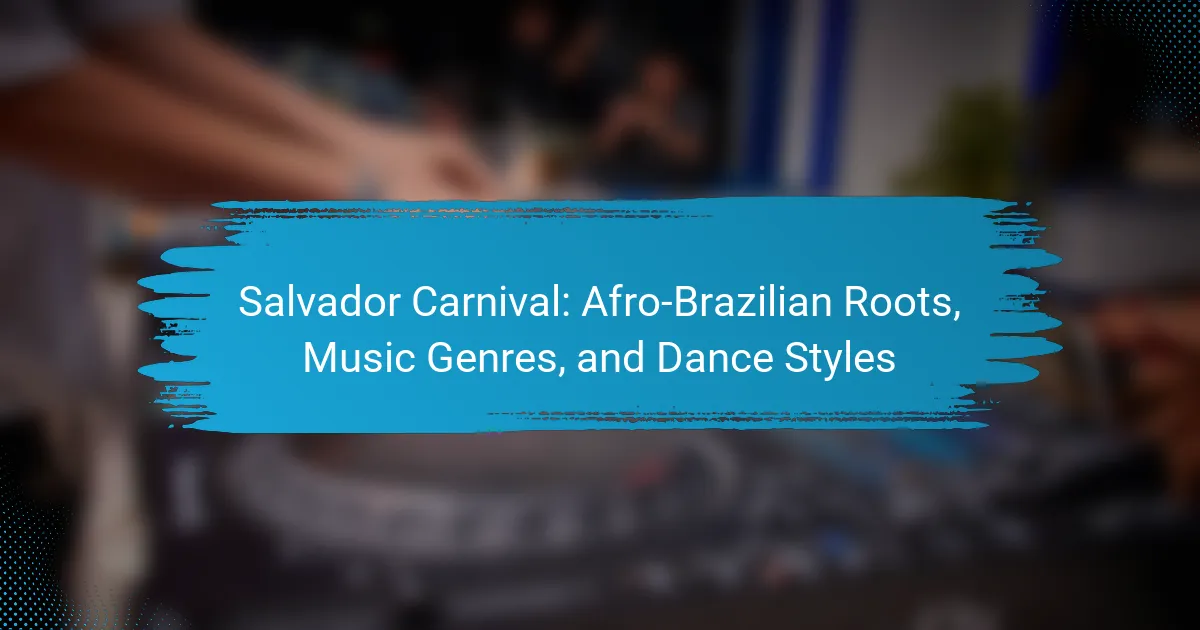The Salvador Carnival is a significant annual festival in Salvador, Brazil, celebrated before Lent and attracting millions of participants and spectators. This vibrant event showcases Afro-Brazilian culture through diverse music genres such as samba, axé, and reggae, accompanied by elaborate costumes and dynamic dance performances. The festival, which has roots in African traditions brought to Brazil by enslaved people, features various dance styles, including samba, axé, and maculelê, reflecting the rich cultural heritage of Bahia. Since its inception in the 18th century, the Salvador Carnival has evolved into one of the largest carnivals globally, emphasizing the importance of music and dance in its celebrations.

What is the Salvador Carnival?
The Salvador Carnival is a major annual festival held in Salvador, Brazil. It is known for its vibrant parades and street parties. The festival typically takes place before Lent, attracting millions of participants and spectators. Salvador Carnival features diverse music genres, including samba, axé, and reggae. The event showcases Afro-Brazilian culture and traditions. It includes elaborate costumes, dance performances, and live music. The festival has roots in African traditions brought to Brazil by enslaved people. It is one of the largest carnivals in the world, celebrated since the 18th century.
How did the Salvador Carnival originate?
The Salvador Carnival originated in the early 18th century. It began as a celebration of the Catholic feast of Epiphany. Initially, it featured street processions and music performed by local musicians. Over time, African influences became prominent in the festivities. Enslaved Africans contributed their cultural practices and rhythms. This fusion created a unique blend of music and dance. The carnival evolved into a major cultural event in Brazil. Today, it attracts millions of participants and spectators each year.
What historical events influenced the creation of the Salvador Carnival?
The Salvador Carnival was influenced by several historical events. The arrival of African slaves in Brazil during the 16th century introduced rich cultural traditions. These traditions included music, dance, and religious practices that became integral to Brazilian culture. The blending of African, Indigenous, and Portuguese influences shaped the carnival’s unique identity.
In the late 19th century, the establishment of organized street parades marked a significant evolution. The creation of the first official carnival in Salvador occurred in 1930. This event solidified the carnival’s role as a major cultural celebration. The influence of samba, which gained popularity in the early 20th century, further enriched the carnival’s musical landscape.
Additionally, the political context, including Brazil’s transition to a republic, played a role in shaping the carnival’s themes and expressions. The Salvador Carnival reflects a historical tapestry of resistance, celebration, and cultural fusion.
How do Afro-Brazilian roots shape the identity of the Salvador Carnival?
Afro-Brazilian roots significantly shape the identity of the Salvador Carnival. The carnival celebrates African heritage through music, dance, and cultural expressions. Key genres like samba and axé originate from African rhythms and traditions. These musical styles reflect the historical influence of African slaves in Brazil. The vibrant costumes and dance movements also draw from African cultural practices. Rituals and communal celebrations highlight the importance of community in Afro-Brazilian culture. Festivals often include elements of Candomblé, an Afro-Brazilian religion. This blend of cultural influences creates a unique and dynamic carnival experience. Salvador Carnival showcases the resilience and creativity of Afro-Brazilian identity.
What are the key features of the Salvador Carnival?
The key features of the Salvador Carnival include vibrant parades, diverse music genres, and traditional dance styles. The parades showcase colorful floats and elaborate costumes. Participants often join in the festivities, dancing along the streets. Music genres like axé, samba, and reggae fill the air. The event attracts millions of visitors each year, highlighting its cultural significance. Salvador Carnival is rooted in Afro-Brazilian traditions, celebrating the city’s rich heritage. The festival typically lasts for six days, culminating in a grand finale. Street parties, known as “blocos,” offer a communal experience for revelers.
What types of music are celebrated during the Salvador Carnival?
The Salvador Carnival celebrates various music genres, prominently including Axé, Samba, and Pagode. Axé music is a fusion of Afro-Brazilian rhythms and Caribbean influences. It originated in the 1980s and is characterized by its upbeat tempo and festive lyrics. Samba, rooted in African traditions, is also a key genre, known for its rhythmic and lively beats. Pagode, a subgenre of Samba, features more intimate themes and acoustic instruments. These genres create a vibrant atmosphere during the carnival, attracting millions of participants and spectators each year. The festival showcases live performances, parades, and music that embody the cultural heritage of Bahia.
How do the various dance styles contribute to the overall experience?
Various dance styles enhance the overall experience of Salvador Carnival by embodying cultural expressions. Each dance style reflects unique historical and social contexts. For instance, Samba’s rhythmic movements promote joy and community bonding. Axé dance incorporates vibrant choreography, energizing participants and spectators alike. Capoeira blends martial arts with dance, showcasing agility and strength. These styles engage audiences, creating a dynamic atmosphere. The diversity of movements fosters inclusivity and cultural appreciation among attendees. Overall, the interplay of different dance styles enriches the celebratory spirit of the carnival.
Why is the Salvador Carnival significant to Brazilian culture?
The Salvador Carnival is significant to Brazilian culture due to its deep Afro-Brazilian roots and vibrant expression of identity. It showcases a blend of African traditions, music, and dance that reflect Brazil’s diverse heritage. The event attracts millions of participants and spectators each year, highlighting its importance as a cultural phenomenon. The music genres featured, such as samba and axé, are integral to the nation’s cultural landscape. Additionally, the carnival serves as a platform for social commentary and community empowerment. Its historical origins date back to the 18th century, emphasizing its longstanding role in Brazilian society. Overall, the Salvador Carnival embodies the spirit and resilience of Afro-Brazilian culture, making it a cornerstone of national identity.
What role does the Salvador Carnival play in promoting Afro-Brazilian heritage?
The Salvador Carnival plays a crucial role in promoting Afro-Brazilian heritage. It showcases the cultural expressions of Afro-Brazilian communities through music, dance, and traditional attire. The event features genres like samba, axé, and maracatu, which are deeply rooted in African traditions. Participants often wear vibrant costumes that reflect African influences. The carnival attracts millions of visitors, raising awareness about Afro-Brazilian culture. It also provides a platform for Afro-Brazilian artists to gain visibility and recognition. The event fosters community pride and cultural continuity among Afro-Brazilian descendants. Historical roots of the carnival trace back to African religious practices and celebrations, reinforcing its significance in preserving heritage.
How does the Carnival foster community and social cohesion?
The Carnival fosters community and social cohesion by bringing people together through shared cultural experiences. It creates a sense of belonging among participants. The event showcases Afro-Brazilian heritage, reinforcing cultural identity. Music and dance serve as unifying elements, encouraging collective participation. Community groups, known as blocos, promote collaboration and social interaction. These groups often represent neighborhoods, strengthening local ties. The Carnival also encourages inclusivity, allowing diverse groups to participate. This collective celebration enhances social bonds and fosters mutual respect among attendees.

What music genres are prominent in the Salvador Carnival?
The prominent music genres in the Salvador Carnival include Axé, Samba, and Pagode. Axé music originated in the 1980s and combines Afro-Brazilian rhythms with Caribbean influences. It is characterized by its upbeat tempo and festive lyrics, making it ideal for the carnival atmosphere. Samba, another key genre, has deep roots in Brazilian culture and is known for its rhythmic complexity and vibrant dance. Pagode is a subgenre of Samba that emerged in the 1980s, emphasizing a more relaxed and intimate style. These genres reflect the rich cultural heritage of Bahia and are integral to the celebration’s identity. The Salvador Carnival attracts millions, showcasing these music styles through parades and street parties.
How do different music genres influence the atmosphere of the Carnival?
Different music genres significantly influence the atmosphere of the Carnival. Each genre brings its unique rhythm, energy, and cultural significance. For instance, samba creates a lively and vibrant environment. It encourages dance and communal celebration, which is central to Carnival. Axé music adds a festive and upbeat feel, promoting participation among attendees. The incorporation of reggae introduces a laid-back vibe, contrasting with the high-energy genres. Additionally, forró can evoke a sense of nostalgia and traditional cultural pride. Research indicates that music genres shape emotional responses and social interactions during events like Carnival. This highlights the importance of musical diversity in enhancing the overall experience.
What are the origins of Axé music in the context of the Carnival?
Axé music originated in the 1980s in Salvador, Brazil, as a fusion of various musical genres. It combines elements of Afro-Brazilian rhythms, such as samba and reggae, with pop music influences. The genre gained popularity during the Carnival, becoming a central feature of the festivities. Axé music is characterized by its upbeat tempo and catchy melodies, making it ideal for dance and celebration. Artists like Daniela Mercury and Ivete Sangalo played significant roles in popularizing Axé music. The genre reflects the cultural diversity of Bahia and its African heritage. Axé music has since influenced other music styles and remains a staple of Brazilian Carnival celebrations.
How does Samba de Roda differ from other genres featured at the Carnival?
Samba de Roda is distinct from other genres at the Carnival due to its strong cultural roots and participatory nature. It originated in the Afro-Brazilian community of Bahia. This genre emphasizes circle dancing, where participants engage in spontaneous performances. Unlike other styles, Samba de Roda often incorporates traditional instruments like the berimbau and atabaque. It also features call-and-response singing, creating a communal atmosphere. This form of samba is recognized as an Intangible Cultural Heritage by UNESCO. Its focus on community participation sets it apart from more formalized genres like Samba Enredo.
What role do live performances play in the Salvador Carnival?
Live performances are central to the Salvador Carnival. They create an immersive atmosphere that engages participants and spectators. These performances showcase a variety of music genres, including samba and axé. They highlight Afro-Brazilian cultural heritage, connecting the community to its roots. Performers often include local artists and international acts, enhancing the festival’s appeal. The energy generated by live music encourages dancing and celebration among attendees. Each year, millions attend to experience these vibrant performances firsthand. This dynamic interaction fosters a sense of unity and cultural pride during the event.
Who are the most notable artists and bands associated with the Carnival?
Notable artists and bands associated with the Carnival include Olodum, a prominent Afro-Brazilian percussion group. Another significant entity is Timbalada, known for its energetic drumming and vibrant performances. Ivete Sangalo is a famous singer who draws large crowds during the festivities. Daniela Mercury also stands out for her contributions to the music scene at Carnival. These artists and bands are integral to the celebration, showcasing the rich musical heritage of Salvador Carnival. Their performances highlight the fusion of Afro-Brazilian rhythms and contemporary styles, making the event a vibrant cultural experience.
How do performances enhance the cultural experience for attendees?
Performances enhance the cultural experience for attendees by providing immersive engagement with traditions. They showcase Afro-Brazilian music and dance, creating a vibrant atmosphere. Attendees witness live expressions of cultural heritage. This fosters a deeper understanding of the community’s history and values. The Salvador Carnival features performances that celebrate unity and diversity. These performances often include traditional instruments and rhythms unique to the region. Engaging with performers allows attendees to connect emotionally with the culture. Research indicates that live performances can increase cultural appreciation and awareness among audiences.

What dance styles are showcased during the Salvador Carnival?
The dance styles showcased during the Salvador Carnival include Samba, Axé, and Maculelê. Samba is a vibrant dance characterized by fast-paced rhythms and lively movements. It has roots in African rhythms and Brazilian culture. Axé is a genre that combines Afro-Brazilian rhythms with Caribbean influences, promoting energetic dance. Maculelê is a traditional dance with roots in capoeira, featuring sticks and lively choreography. These styles reflect the rich cultural heritage of Bahia and are integral to the carnival celebrations.
How do traditional dance styles reflect the Carnival’s Afro-Brazilian roots?
Traditional dance styles reflect the Carnival’s Afro-Brazilian roots through their origins and movements. These dances, such as samba and axé, are deeply influenced by African rhythms and cultural expressions. They incorporate elements like call-and-response patterns and polyrhythmic beats, which are hallmarks of African music traditions. Furthermore, the costumes and choreography often symbolize African heritage and [censured]. Historical records indicate that these dance forms evolved from the African slaves’ cultural practices in Brazil. The vibrant expressions seen during Carnival are a celebration of this heritage, showcasing the resilience and creativity of Afro-Brazilian communities. The dances serve as a means of cultural identity and continuity, reinforcing the connection to African ancestry.
What are the key characteristics of Samba and its variations in the Carnival?
Samba is a vibrant and rhythmic music genre and dance style integral to Carnival celebrations. It is characterized by its syncopated rhythms, energetic movements, and lively instrumentation. Samba music often features percussion instruments like drums and tambourines, creating an infectious beat. The dance style is marked by quick footwork, body isolations, and improvisational elements. Variations of Samba include Samba de Roda, which emphasizes circular dance formations, and Samba Enredo, which is performed during parades and tells a story through song. Each variation reflects regional influences and cultural expressions within Brazilian society. The prominence of Samba in Carnival is evident, as it brings together diverse communities in celebration.
How does Capoeira integrate into the dance culture of the Carnival?
Capoeira integrates into the dance culture of the Carnival by showcasing its unique movements and rhythms. This Brazilian martial art combines elements of dance, acrobatics, and music. During Carnival, Capoeira practitioners perform in the streets, attracting crowds with their dynamic displays. The music played during these performances typically features traditional instruments like the berimbau. This creates an engaging atmosphere that enhances the overall Carnival experience. Capoeira’s cultural significance is rooted in its Afro-Brazilian heritage, reflecting the history and struggles of enslaved Africans. The presence of Capoeira in Carnival celebrations highlights its role in preserving and promoting Afro-Brazilian culture. It fosters community spirit and encourages participation from both performers and spectators.
What are the contemporary influences on dance styles at the Salvador Carnival?
Contemporary influences on dance styles at the Salvador Carnival include global music trends and cultural exchanges. The integration of hip-hop, reggae, and electronic music has transformed traditional Afro-Brazilian dance forms. Dancers often incorporate urban dance styles into their performances. This blend reflects the evolving identity of Brazilian culture. Additionally, social media platforms amplify new dance trends, allowing for rapid dissemination. The influence of international artists also shapes local choreography. Cultural festivals worldwide inspire Salvador’s dance scene, leading to innovative expressions. These factors collectively contribute to the dynamic nature of dance at the Carnival.
How have modern trends reshaped traditional dance forms at the Carnival?
Modern trends have significantly reshaped traditional dance forms at the Carnival. Contemporary influences have introduced new styles and techniques. Traditional dances now incorporate elements of hip-hop, samba-reggae, and other global dance forms. This fusion enhances creativity and attracts younger audiences. Additionally, technology plays a role in choreography and performance. Digital platforms allow for wider dissemination of dance styles. Social media showcases innovative interpretations of traditional dances. These changes reflect evolving cultural expressions within the Carnival context. The integration of modern trends revitalizes traditional dance, ensuring its relevance in contemporary society.
What role do dance workshops play in preparing participants for the Carnival?
Dance workshops play a crucial role in preparing participants for the Carnival. They provide essential training in Afro-Brazilian dance styles, which are integral to the event. Participants learn specific movements that reflect cultural traditions. Workshops also foster teamwork and collaboration among dancers. This preparation enhances performance quality during the Carnival. Additionally, workshops build confidence and stage presence. According to a study by the University of Bahia, participants who attend workshops demonstrate improved rhythm and coordination. Overall, dance workshops are vital for effective Carnival participation.
What tips can attendees follow to fully enjoy the Salvador Carnival experience?
To fully enjoy the Salvador Carnival experience, attendees should plan ahead and arrive early. The event features vibrant parades and street parties that can get crowded. Wearing comfortable clothing and shoes is essential for long hours of dancing and walking. Hydration is crucial; attendees should drink plenty of water throughout the day. Engaging with local culture enhances the experience, so learning basic Portuguese phrases can be beneficial. Attendees should also be mindful of their belongings in crowded areas. Participating in organized blocos can provide a more structured experience. Lastly, embracing the festive spirit and joining in the music and dance is key to enjoying the carnival atmosphere.
The Salvador Carnival is a major annual festival in Salvador, Brazil, celebrated for its vibrant parades, diverse music genres, and rich Afro-Brazilian cultural heritage. Originating in the 18th century, it reflects a blend of African, Indigenous, and Portuguese influences, showcasing traditional dance styles like Samba, Axé, and Maculelê. The event attracts millions of participants each year, highlighting its significance in promoting Afro-Brazilian identity and fostering community cohesion through music and dance. Key artists and genres, such as Olodum and Axé music, contribute to the carnival’s dynamic atmosphere, making it one of the largest and most culturally significant carnivals in the world.
